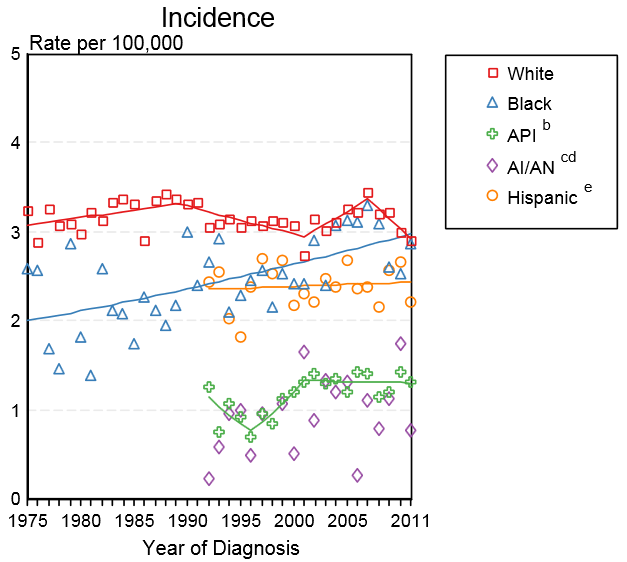Hodgkin's lymphoma epidemiology and demographics
|
Hodgkin's lymphoma Microchapters |
|
Diagnosis |
|---|
|
Treatment |
|
Case Studies |
|
Hodgkin's lymphoma epidemiology and demographics On the Web |
|
American Roentgen Ray Society Images of Hodgkin's lymphoma epidemiology and demographics |
|
Hodgkin's lymphoma epidemiology and demographics in the news |
|
Risk calculators and risk factors for Hodgkin's lymphoma epidemiology and demographics |
Editor-In-Chief: C. Michael Gibson, M.S., M.D. [1]; Associate Editor(s)-in-Chief: Rim Halaby, M.D. [2]
Overview
Unlike some other lymphomas, whose incidence increases with age, Hodgkin's lymphoma has a bimodal incidence curve; that is, it occurs most frequently in two separate age groups, the first being young adulthood (age 15–35) and the second being in those over 55 years old although these peaks may vary slightly with nationality.[1] Overall, Hogkin's lymphoma is reported more in men with the exception of the nodular sclerosis variant. The incidence of Hodgkin's lymphoma is higher among patients with HIV/AIDS; however, in contrast to many other lymphomas associated with HIV infection, Hodgkin's lymphoma occurs most commonly in patients with higher CD4 T cell counts.[2]
Epidemiology and Demographics
Prevalence
- In the United States, the age adjusted prevalence of Hodgkin's lymphoma is 0.035% in 2011.[3]
Incidence
- The delay-adjusted incidence of Hodgkin's lymphoma in 2011 was estimated to be 2.8 per 100,000 persons in the United States.[3]
- In 2011, the age-adjusted incidence of Hodgkin's lymphoma was 2.71 per 100,000 persons in the United States.[3]
Age
- While the overall age adjusted incidence of Hodgkin's lymphoma in the United States between 2007 and 2011 is 2.7 per 100,000, the age-adjusted incidence of Hodgkin's lymphoma by age category is:[3]
- Between 20 and 29 years: 4.1-4,5 per 100,000
- Under 65 years: 2.5 per 100,000
- 65 and over: 4.2 per 100,000
Gender
- In the United States, the age adjusted prevalence of Hodgkin's lymphoma by gender in 2011 is:[3]
- In males: 0.0372%
- In females: 0.0331%
- In the United States, the delay-adjusted incidence of Hodgkin's lymphoma by gender in 2011 is:[3]
- In males: 3.22 per 100,000 persons
- In females: 2.42 per 100,000 persons
- In the United States, the age-adjusted incidence of Hodgkin's lymphoma by gender on 2011 is:[3]
- In males: 3.11 per 100,000 persons
- In females: 2.34 per 100,000 persons
Shown below is an image depicting the delay-adjusted incidence and observed incidence of Hodgkin's lymphoma by gender and race in the United States between 1975 and 2011. These graphs are adapted from SEER: The Surveillance, Epidemiology, and End Results Program of the National Cancer Institute.[3]
Race
- Shown below is a table depicting the age adjusted prevalence of Hodgkin's lymphoma by race in 2011 in the United States.[3]
| All Races | White | Black | Asian/Pacific Islander | Hispanic | |
| Age-adjusted prevalence | 0.035% | 0.04% | 0.0321% | 0.0126% | 0.0236% |
Shown below is an image depicting the incidence of Hodgkin's lymphoma by race in the United States between 1975 and 2011.[3]
API: Asian/Pacific Islander; AI/AN: American Indian/ Alaska Native
References
- ↑ Mauch, Peter (1999). Hodgkin's Disease. Lippincott Williams & Wilkins. pp. 62–64. ISBN 0-7817-1502-4. Unknown parameter
|coauthors=ignored (help) - ↑ Biggar RJ, Jaffe ES, Goedert JJ, Chaturvedi A, Pfeiffer R, Engels EA (2006). "Hodgkin lymphoma and immunodeficiency in persons with HIV/AIDS". Blood. 108 (12): 3786–91. doi:10.1182/blood-2006-05-024109. PMID 16917006.
- ↑ 3.0 3.1 3.2 3.3 3.4 3.5 3.6 3.7 3.8 3.9 Howlader N, Noone AM, Krapcho M, Garshell J, Miller D, Altekruse SF, Kosary CL, Yu M, Ruhl J, Tatalovich Z,Mariotto A, Lewis DR, Chen HS, Feuer EJ, Cronin KA (eds). SEER Cancer Statistics Review, 1975-2011, National Cancer Institute. Bethesda, MD, http://seer.cancer.gov/csr/1975_2011/, based on November 2013 SEER data submission, posted to the SEER web site, April 2014.

